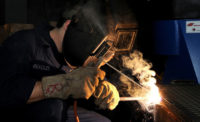 If you haven’t purchased your 20 pound Thanksgiving turkey or your 10 pound bag of potatoes rest assured employees at your local grocery stores are busy restocking the shelves each day with your favorite Thanksgiving foods. It‘s hard enough lifting those items into your cart but what about the workers who haul those tons of turkeys, pounds of potatoes, and stock the shelves with green beans, cranberries, and stuffing? Nearly 2.5 million cashiers and stocking clerks are at risk for musculoskeletal injuries that stem from overexertion in grocery stores. According to Liberty Mutual Research Institute, overexertion is the leading cause of workplace injuries and account for $14.2 billion in direct costs. In the grocery sector, overexertion injuries that lead to soft tissue injuries, A.K.A. musculoskeletal disorders, account for 41% of the injuries and lost work in grocery stores[1].
If you haven’t purchased your 20 pound Thanksgiving turkey or your 10 pound bag of potatoes rest assured employees at your local grocery stores are busy restocking the shelves each day with your favorite Thanksgiving foods. It‘s hard enough lifting those items into your cart but what about the workers who haul those tons of turkeys, pounds of potatoes, and stock the shelves with green beans, cranberries, and stuffing? Nearly 2.5 million cashiers and stocking clerks are at risk for musculoskeletal injuries that stem from overexertion in grocery stores. According to Liberty Mutual Research Institute, overexertion is the leading cause of workplace injuries and account for $14.2 billion in direct costs. In the grocery sector, overexertion injuries that lead to soft tissue injuries, A.K.A. musculoskeletal disorders, account for 41% of the injuries and lost work in grocery stores[1].
One way to prevent these injuries is by using mechanical assist devices such as powered pallet movers, height-adjusted conveyors, and powered adjustable handcarts. A new document from NIOSH, Ergonomic Solutions for Retailers: Prevention of Material Handling Injuries in the Grocery Sector, illustrates the use of mechanical assist devices for reducing manual materials handling injuries in retail grocery work. These devices prevent injury and can help reduce the impact of aging allowing older workers to stay on their jobs even with physical limitations.









